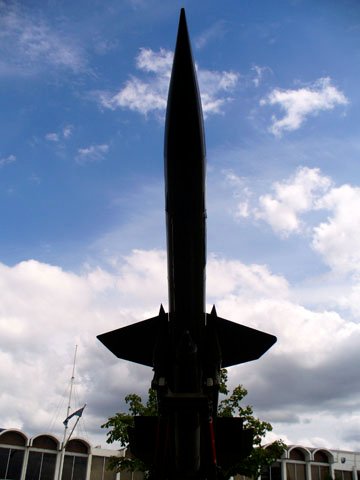
On my first Saturday here, I spent the morning printing out pages from the Daily Mail at British Library Newspapers in Colindale, and then headed over to the nearby RAF Museum London for an afternoon wandering around the historic aircraft. The problem with this is that it meant I had to carry with me (a) my laptop and (b) a thick sheaf of printouts. This was not too hard at first, but as the day wore on my feet got sore, and my arms got weary, and both my patience and my ability to hold a camera still decreased as a result. When combined with the often dimly-lit exhibition halls (including the Battle of Britain hall) this meant that many of my photos didn’t turn out so well. Luckily for you, I’ve weeded out most of the bad ones!
Outside there are a few interesting displays, including some RAF search-and-rescue vessels — yes, boats! — and the following:

This (and the previous image) is a BAC Bloodhound surface-to-air missile. It’s always been one of my favourite missiles, because with all those boosters and fins, it looks like a missile “should”. Very Thunderbirds.

Having a Hurricane (and a Spitfire) sitting outside exposed to the elements seems rather ostentatious!
I made the mistake of eating at the cafe, then entered the Battle of Britain Hall.

The poor old Defiant, here in night-fighter mode. Despite the turret, very pleasing to the eye.
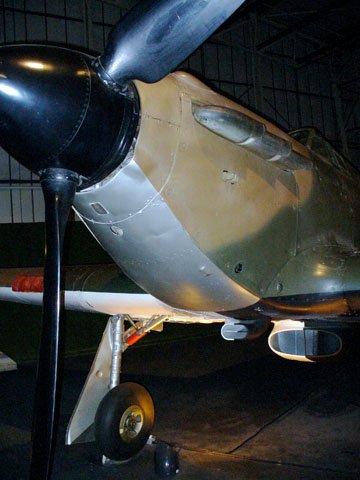
This Hurricane is mainly of interest because it shows the early-war underside paint scheme, black and white, intended to make it easier to distinguish friend from foe. But it seems it also made the aircraft easier to see, and so from June 1940 the switch was made to the more familiar pale blue.

For some reason, several of the German aircraft in the Battle of Britain hall were actually night-fighter variants, like this Me 110 and a Ju 88 — i.e., not much like the types actually present in the Battle. I suppose there were more of these around at the end of the war when most of these warbirds were captured?

A Stuka. And a mannequin. I have a low tolerance for mannequins in museums, and unfortunately the Battle of Britain hall has them at every turn, including at least one with a missing hand. (On the other hand, I love models and dioramas, and the RAF Museum doesn’t. Oh well.)

The Lysander army co-operation aircraft, probably best known for its role in landing SOE agents in occupied Europe. Looking at it, “sturdy” is the word that comes to mind; I do like the headlights on the spats!
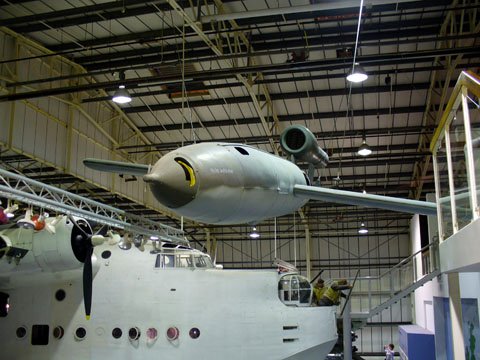
Look out, it’s a revenge weapon! Aieee! And behind it, a Sunderland, the “flying porcupine” (though the British press called them “flying battleships”, at least at first). You get to walk through this, which as a devotee of flying boats I of course loved.
The Milestones of Flight exhibit was crammed full of significant aircraft (and thankfully, well-lit).

Now they’re just showing off! If you’ve got a few to spare, why not stick a Spitfire up on the wall, with paint stripped back to the metal and propeller blades removed? (It does show off the small dimples in the skin, though.)
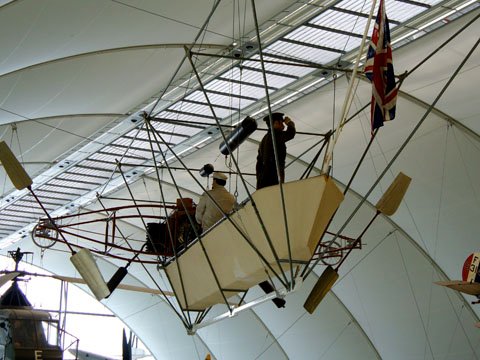
I think this is a replica of the gondola for HM Airship Nulli Secundus I, “Second to None”, so called because it was pretty obviously second to every other airship around — that’s the story I like, anyway! This flew in 1907, was wrecked in a rain shower and was rebuilt the following year, as the slightly more successful Nulli Secundus II.

The Sopwith Camel, a true classic. Behind it, there’s an AGM-86 cruise missile and a Sikorsky Hoverfly, probably the first helicopter to go into production.
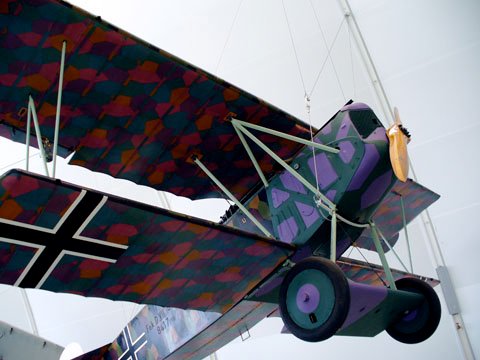
Also behind it is a Fokker D.VII … watch out, Biggles!
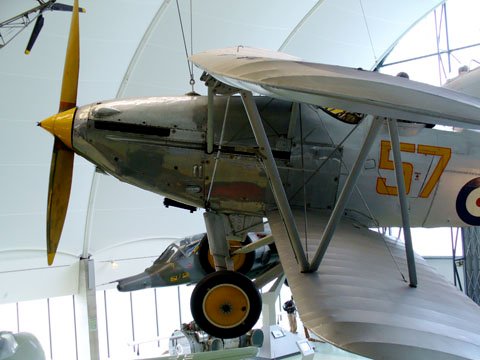
The Hawker Hart day bomber, at one point the fastest aircraft in the RAF inventory. It must be one of the few bombers to have spawned a successful fighter variant! (Outside of night-fighters, that is.)
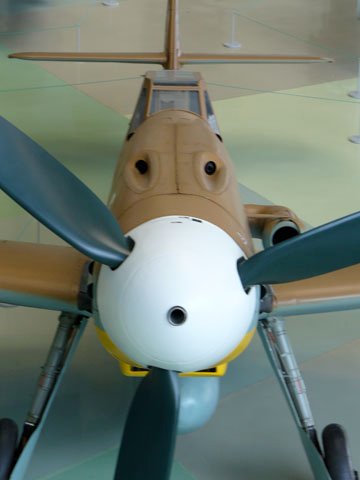
Business end of a Me 109G, a mid-war variant. Yes, technically I should probably say “Bf 109”, but the British press nearly always called them Me 109s, so I’ll stick with that.

A rare Ki-100 of the Japanese Army, a late-war fighter.

The Me 262 jet fighter. I like this angle because it looks like it’s thinking about making a run for it …

As much as I could fit in frame of a Mosquito.

The Mustang: shiny!
Now into the Bomber Hall, where I have very few non-blurry photos.
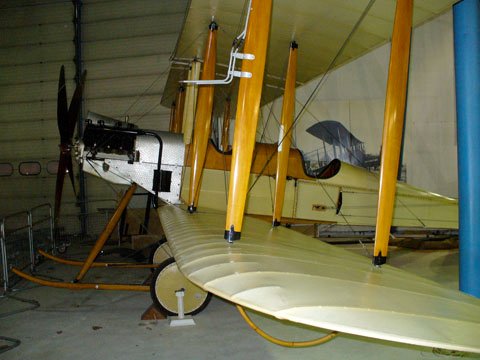
This is a Be2b, an early RFC bomber/observation aeroplane (in fact it was in service at the start of the First World War). The engine always looks way too small on this thing.

The capacious Lancaster.
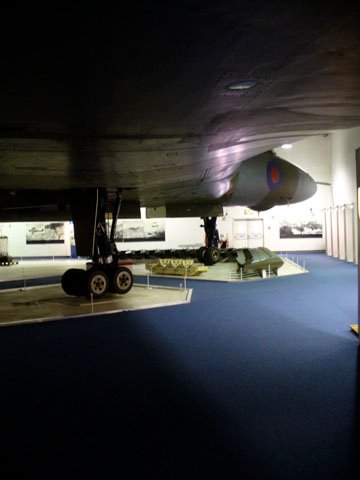
Underneath the big wing of a Vulcan.
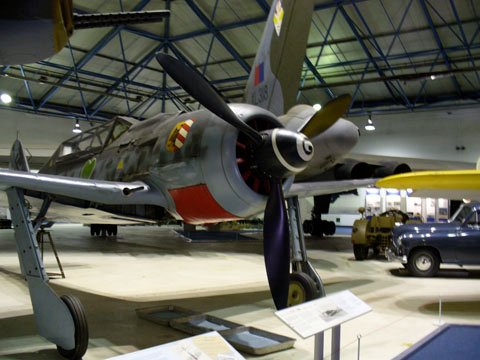
Finally — and I’m not really sure what it’s doing in the Bomber Hall — a Focke-Wulf Fw 190.
There’s still plenty more I didn’t see (including the Grahame-White Factory Collection — the Museum site is, I believe, roughly congruent with the old Hendon display aerodrome), so hopefully I’ll get a chance to go back before I go home.
![]() This work is licensed under a Creative Commons Attribution-NonCommercial-NoDerivatives 4.0 International License.
Permissions beyond the scope of this license may be available at http://airminded.org/copyright/.
This work is licensed under a Creative Commons Attribution-NonCommercial-NoDerivatives 4.0 International License.
Permissions beyond the scope of this license may be available at http://airminded.org/copyright/.



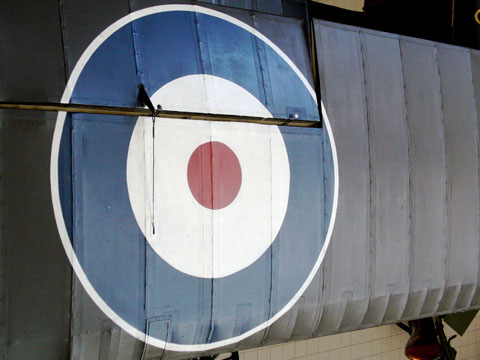
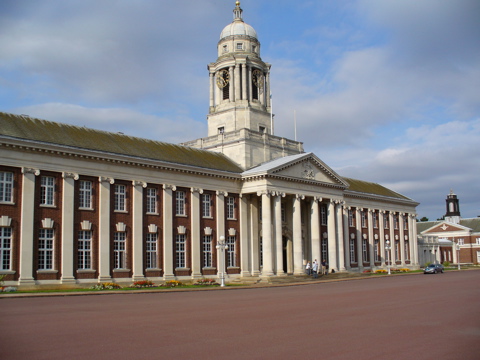

Nice pictures!
Well, as I said there were a lot of really awful ones. Some I can’t even make out what the camera was pointed at!
I believe the Spit and Hurricane outside are replicas, so it’s not *too* ostentatious.
Aren’t there some model and dioramas in the bit at the beginning of the fighter hall? If you do make it up there, both Duxford and Cosford have some pretty decent displays – as well as, y’know, TSR-2! And other good stuff.
Brett – Some great pics. The museum is well worth a visit. The library/archives are good too. Many interesting papers in there.
What did you think of the Battle of Britain lights-and-sparkles extravaganza they show every hour or so? It’s cheesy as hell (though I’ve sat through it on two separate occasions, so maybe they know that they’re doing).
Also, my wife sat through the Sopwith Camel dogfight simulator even though she was (unknowingly) three months pregnant at the time. Certainly our son has proved to have a bounce in his step.
Jakob:
You’re right about the replicas — comparing the 3rd and 5th photos above shows that they’re very well done though! I didn’t make it as far as the fighters this time around. I definitely hope to make it to Duxford, not sure about Cosford …
Ross:
Thanks, and there are definitely a few things I want to look at in their archives when I get round to it!
Alan:
Oh, I thought it was pretty good as those things go — it was informative and held the attention of the spectator well enough. What annoyed me though was that they have to close off access to the BoB section while it’s playing (ie because its dark and to stop others from blundering in while the show is on), and that even when it’s not the whole section is too dimly lit for photography.
Pingback: Airminded · RAF Museum London 2
My colleague and I drove up to Hendon on the 13th January having made several visits to Cosford. Our last visit to Hendon was thirty years ago but the absence of the Beverly was noticeable. Taking photographs in both museums is difficult, the exhibits being displayed in close proximety to each other – understandable given their sizes and space considerations. A wide angle lens and good flash gun, I am unsure on the policy for tripods. Having, within the last six months, been to both to the Luftewaffe Museum in Berlin and the Netherlands Air Force Museum in Soest, the former having much of its display aircraft completely exposed to the elements, Hendon and Cosford compare very favourably. Another visit is on the cards despite Hendon being in the London suberbs. One last comment on museums in general, the exhibits seem to be set out by people who do not take photographs ……
That’s something that I’ve noticed too — they’re either too dark, or too glarey, or something …
Sweet! Thanks!!